一入爬虫深似海,从此游戏是路人!总结我的pytho…
2019-03-13 23:37:23来源:博客园 阅读 ()


前言
还记得是大学2年级的时候,偶然之间看到了学长在学习python;我就坐在旁边看他敲着代码,感觉很好奇。感觉很酷,从那之后,我就想和学长一样的厉害,就想让学长教我,请他吃了一周的饭,他答应了。从此,我踏上了python编程的道路。在那之前,我成天到晚都是在打lol;但是从那天之后,几乎很少很少了。
然而到如今,这一学就是2年,我已经不再是一名小白。是的,我爱上了编程,爱上了python。如今,人工智能的时代已经来临,作为它的首选语言 python。我很自豪,今天给大家分享一下我当初学习爬虫的心得体会。
正文
〇. python 基础
先放上python 3 的官方文档:https://docs.python.org/3/ (看文档是个好习惯)
关于python 3 基础语法方面的东西,网上有很多,大家可以自行查找.
一. 最简单的爬取程序
爬取百度首页源代码:

来看上面的代码:
- 对于python 3来说,urllib是一个非常重要的一个模块 ,可以非常方便的模拟浏览器访问互联网,对于python 3 爬虫来说, urllib更是一个必不可少的模块,它可以帮助我们方便地处理URL.
- urllib.request是urllib的一个子模块,可以打开和处理一些复杂的网址
The urllib.requestmodule defines functions and classes which help in opening URLs (mostly HTTP) in a complex world — basic and digest authentication, redirections, cookies and more.
- urllib.request.urlopen()方法实现了打开url,并返回一个 http.client.HTTPResponse对象,通过http.client.HTTPResponse的read()方法,获得response body,转码最后通过print()打印出来.
urllib.request.urlopen(url, data=None, [timeout, ]***, cafile=None, capath=None, cadefault=False, context=None)For HTTP and HTTPS URLs, this function returns a http.client.HTTPResponseobject slightly modified.< 出自: https://docs.python.org/3/library/urllib.request.html >
- decode('utf-8')用来将页面转换成utf-8的编码格式,否则会出现乱码
二 模拟浏览器爬取信息
在访问某些网站的时候,网站通常会用判断访问是否带有头文件来鉴别该访问是否为爬虫,用来作为反爬取的一种策略。
先来看一下Chrome的头信息(F12打开开发者模式)如下:
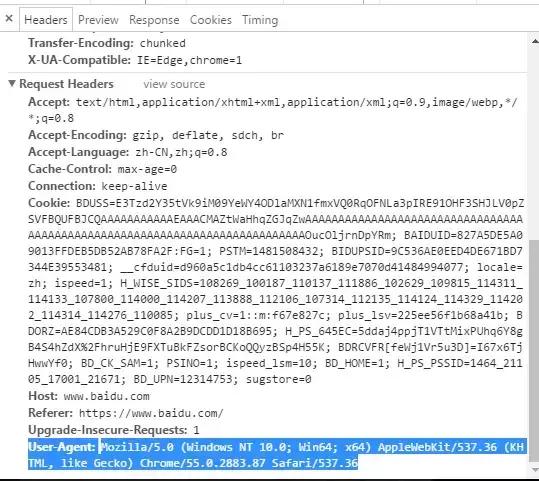
如图,访问头信息中显示了浏览器以及系统的信息(headers所含信息众多,具体可自行查询)
Python中urllib中的request模块提供了模拟浏览器访问的功能,代码如下:
from urllib import request
url = 'http://www.baidu.com'
# page = request.Request(url)
# page.add_header('User-Agent', 'Mozilla/5.0 (Windows NT 10.0; Win64; x64) AppleWebKit/537.36 (KHTML, like Gecko) Chrome/55.0.2883.87 Safari/537.36')
headers = {'User-Agent':'Mozilla/5.0 (Windows NT 10.0; Win64; x64) AppleWebKit/537.36 (KHTML, like Gecko) Chrome/55.0.2883.87 Safari/537.36'}
page = request.Request(url, headers=headers)
page_info = request.urlopen(page).read().decode('utf-8')
print(page_info)
可以通过add_header(key, value) 或者直接以参数的形式和URL一起请求访问,urllib.request.Request()
urllib.request.Request(url, data=None, headers={}, origin_req_host=None, unverifiable=False, method=None)
三 爬虫利器Beautiful Soup
Beautiful Soup是一个可以从HTML或XML文件中提取数据的Python库.它能够通过你喜欢的转换器实现惯用的文档导航,查找,修改文档的方式.
文档中的例子其实说的已经比较清楚了,那下面就以爬取简书首页文章的标题一段代码来演示一下:
先来看简书首页的源代码:
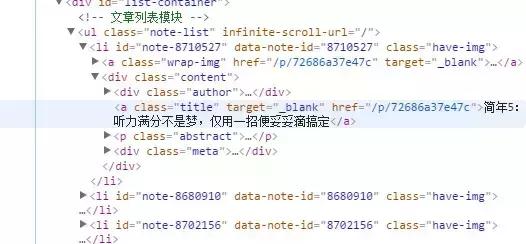
可以发现简书首页文章的标题都是在<a/>标签中,并且class='title',所以,通过
find_all('a', 'title')
便可获得所有的文章标题,具体实现代码及结果如下:
# -*- coding:utf-8 -*-
from urllib import request
from bs4 import BeautifulSoup
url = r'http://www.jianshu.com'
# 模拟真实浏览器进行访问
headers = {'User-Agent':'Mozilla/5.0 (Windows NT 10.0; WOW64) AppleWebKit/537.36 (KHTML, like Gecko) Chrome/55.0.2883.87 Safari/537.36'}
page = request.Request(url, headers=headers)
page_info = request.urlopen(page).read()
page_info = page_info.decode('utf-8')
# 将获取到的内容转换成BeautifulSoup格式,并将html.parser作为解析器
soup = BeautifulSoup(page_info, 'html.parser')
# 以格式化的形式打印html
# print(soup.prettify())
titles = soup.find_all('a', 'title') # 查找所有a标签中class='title'的语句
# 打印查找到的每一个a标签的string
for title in titles:
print(title.string)
Beautiful Soup支持Python标准库中的HTML解析器,还支持一些第三方的解析器,下表列出了主要的解析器,以及它们的优缺点:
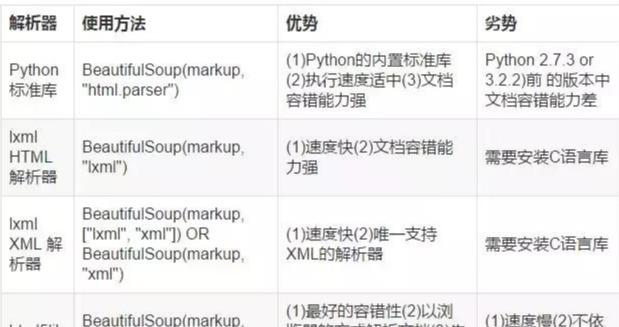
四 将爬取的信息存储到本地
之前我们都是将爬取的数据直接打印到了控制台上,这样显然不利于我们对数据的分析利用,也不利于保存,所以现在就来看一下如何将爬取的数据存储到本地硬盘。
1 对.txt文件的操作
读写文件是最常见的操作之一,python3 内置了读写文件的函数:open
open(file, mode='r', buffering=-1, encoding=None, errors=None, newline=None, closefd=True, opener=None))Open file and return a corresponding file object. If the file cannot be opened, an OSErroris raised.
其中比较常用的参数为file和mode,参数file为文件的路径,参数mode为操作文件的方式(读/写),函数的返回值为一个file对象,如果文件操作出现异常的话,则会抛出 一个OSError
还以简书首页文章题目为例,将爬取到的文章标题存放到一个.txt文件中,具体代码如下:
# -*- coding:utf-8 -*-
from urllib import request
from bs4 import BeautifulSoup
url = r'http://www.jianshu.com'
headers = {'User-Agent':'Mozilla/5.0 (Windows NT 10.0; WOW64) AppleWebKit/537.36 (KHTML, like Gecko) Chrome/55.0.2883.87 Safari/537.36'}
page = request.Request(url, headers=headers)
page_info = request.urlopen(page).read().decode('utf-8')
soup = BeautifulSoup(page_info, 'html.parser')
titles = soup.find_all('a', 'title')
try:
# 在E盘以只写的方式打开/创建一个名为 titles 的txt文件
file = open(r'E: itles.txt', 'w')
for title in titles:
# 将爬去到的文章题目写入txt中
file.write(title.string + ' ')
finally:
if file:
# 关闭文件(很重要)
file.close()
open中mode参数的含义见下表:
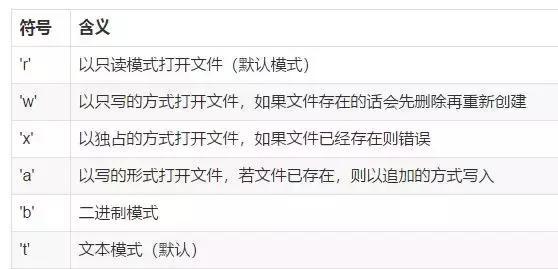
其中't'为默认模式,'r'相当于'rt',符号可以叠加使用,像'r+b'
另外,对文件操作一定要注意的一点是:打开的文件一定要关闭,否则会占用相当大的系统资源,所以对文件的操作最好使用try:...finally:...的形式。但是try:...finally:...的形式会使代码显得比较杂乱,所幸python中的with语句可以帮我们自动调用close()而不需要我们写出来,所以,上面代码中的try:...finally:...可使用下面的with语句来代替:
with open(r'E: itle.txt', 'w') as file:
for title in titles:
file.write(title.string + ' ')
效果是一样的,建议使用with语句

2 图片的储存
有时候我们的爬虫不一定只是爬取文本数据,也会爬取一些图片,下面就来看怎么将爬取的图片存到本地磁盘。
我们先来选好目标,知乎话题:女生怎么健身锻造好身材? (单纯因为图多,不要多想哦 (# _ # ) )
看下页面的源代码,找到话题下图片链接的格式,如图:
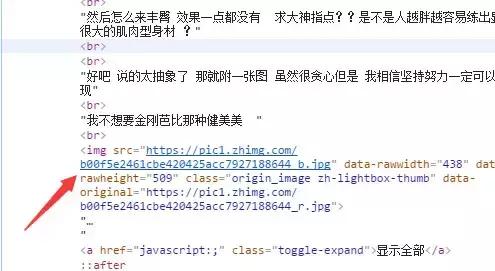
可以看到,图片在img标签中,且class=origin_image zh-lightbox-thumb,而且链接是由.jpg结尾,我们便可以用Beautiful Soup结合正则表达式的方式来提取所有链接,如下:
links = soup.find_all('img', "origin_image zh-lightbox-thumb",src=re.compile(r'.jpg$'))
提取出所有链接后,使用request.urlretrieve来将所有链接保存到本地
Copy a network object denoted by a URL to a local file. If the URL points to a local file, the object will not be copied unless filename is supplied. Return a tuple (filename, headers)where filename is the local file name under which the object can be found, and headers is whatever the info()method of the object returned by urlopen()returned (for a remote object). Exceptions are the same as for urlopen().
具体实现代码如下:
# -*- coding:utf-8 -*-
import time
from urllib import request
from bs4 import BeautifulSoup
import re
url = r'https://www.zhihu.com/question/22918070'
headers = {'User-Agent':'Mozilla/5.0 (Windows NT 10.0; WOW64) AppleWebKit/537.36 (KHTML, like Gecko) Chrome/55.0.2883.87 Safari/537.36'}
page = request.Request(url, headers=headers)
page_info = request.urlopen(page).read().decode('utf-8')
soup = BeautifulSoup(page_info, 'html.parser')
# Beautiful Soup和正则表达式结合,提取出所有图片的链接(img标签中,class=**,以.jpg结尾的链接)
links = soup.find_all('img', "origin_image zh-lightbox-thumb",src=re.compile(r'.jpg$'))
# 设置保存的路径,否则会保存到程序当前路径
local_path = r'E:Pic'
for link in links:
print(link.attrs['src'])
# 保存链接并命名,time防止命名冲突
request.urlretrieve(link.attrs['src'], local_path+r'%s.jpg' % time.time())
运行结果

原文链接:https://www.cnblogs.com/qingdeng123/p/10517242.html
如有疑问请与原作者联系
标签:
版权申明:本站文章部分自网络,如有侵权,请联系:west999com@outlook.com
特别注意:本站所有转载文章言论不代表本站观点,本站所提供的摄影照片,插画,设计作品,如需使用,请与原作者联系,版权归原作者所有
- 小白如何入门 Python 爬虫? 2019-08-13
- python day2-爬虫实现github登录 2019-08-13
- python爬虫学习之爬取超清唯美壁纸 2019-08-13
- python爬虫学习之用Python抢火车票的简单小程序 2019-08-13
- python爬虫常用库 2019-08-13
IDC资讯: 主机资讯 注册资讯 托管资讯 vps资讯 网站建设
网站运营: 建站经验 策划盈利 搜索优化 网站推广 免费资源
网络编程: Asp.Net编程 Asp编程 Php编程 Xml编程 Access Mssql Mysql 其它
服务器技术: Web服务器 Ftp服务器 Mail服务器 Dns服务器 安全防护
软件技巧: 其它软件 Word Excel Powerpoint Ghost Vista QQ空间 QQ FlashGet 迅雷
网页制作: FrontPages Dreamweaver Javascript css photoshop fireworks Flash
